
8 companies improving in-person retail with mobile apps
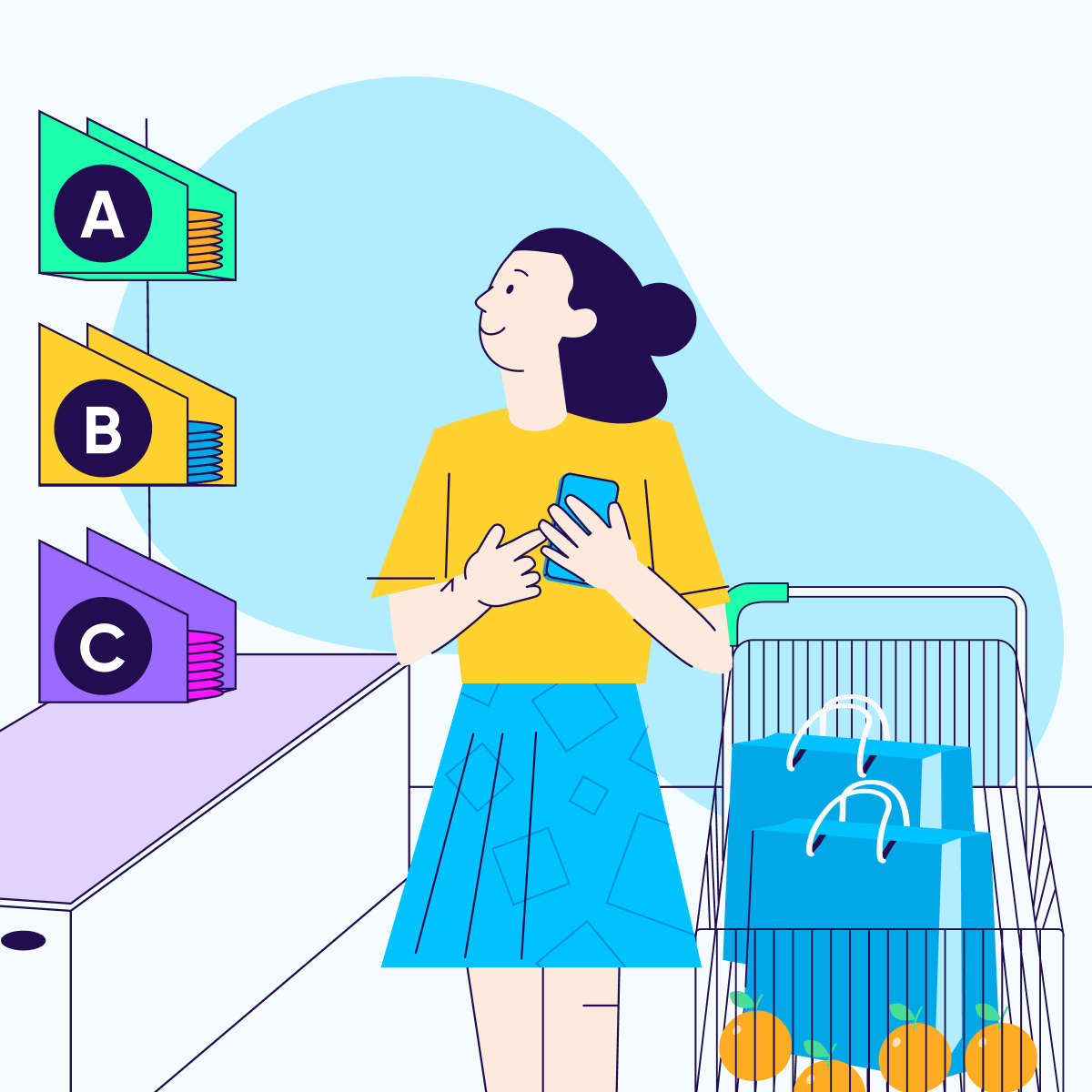
Are we witnessing the extinction of the in-person shopper?
Before the pandemic forced a record number of store closings, we heard about the “existential reckoning” in retail as shoppers shifted their habits from strolling aisles to virtual visits.
But despite the rise in digital, a recent study from Raydiant—an experience management platform—showed that roughly 50% of people still prefer to shop at a physical store.
And when Hermés reopened its Guangzhou location in April of 2020, shoppers flocked to spend a record $2.7 million in a single day—much of that on items they could have ordered online.
It seems the rumors of brick-and-mortar’s demise are somewhat exaggerated.
What has changed is how people think about their path to purchasing and which touchpoints do they go through on their shopping journey
In this post, we’ll show you how 8 leading brands adapted to create the right mix to drive customer delight.
The integrated approach wins
Most (73% according to Harvard Business Review) say they prefer to combine in-person and online experiences, while 57% say they’ve used a retailer’s mobile app while in one of its physical locations.
This trend has been in the works for a while. Way back in 2015, Target CEO Brian Cornell observed that “on Black Friday, 10% of our iPhone app revenue was from guests purchasing on their phone while they were simultaneously shopping one of our stores.”
A successful customer/brand relationship doesn’t separate digital and physical channels. Instead, it creates an integrated experience that delights shoppers as they seamlessly flow from online to in-person encounters.
The eight retailers and consumer brands on this list exemplify the point. They’ve used their apps to drive foot traffic while making the in-person shopping experience easier, safer, and way more fun.
Burger King’s geofence offensive
Burger King pulled some of the greatest tech-enabled trolling in fast-food history while simultaneously showing how an app can drive lots of foot traffic.
In 2018, BK set up geofences around 14,000 McDonald’s locations. A geofence is a virtual perimeter around a physical location that can detect app users who have opted in to location services.
The King then gave out virtual coupons good for a 1-cent Whopper, but only to people who opened their app within 600 feet of a McDonald’s.
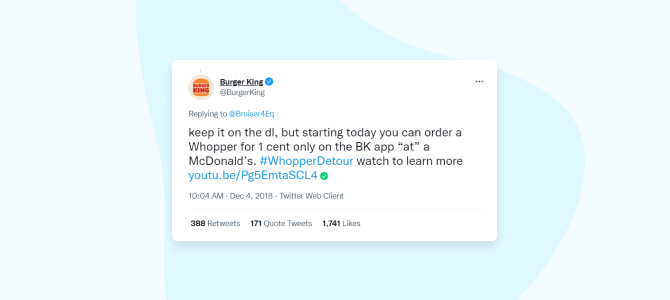
The #whopperdetour campaign won awards and generated 1.5 million app downloads.
The lesson
You don’t have to be as aggressive or diabolical as BK to drive foot traffic with your app. Instead, offer time-sensitive, in-store-only deals to customers who have opted in to location services on your app when they’re in the neighborhood.
The Gap’s in-stock solution
It’s frustrating when you want to buy something but the store you drove to is out of stock. The Gap has two built-in features on its app to keep its customers from experiencing that fate.
First, shoppers can check stock at a local store on the Gap app. They just pick a location and a product to see if it’s on the shelf.
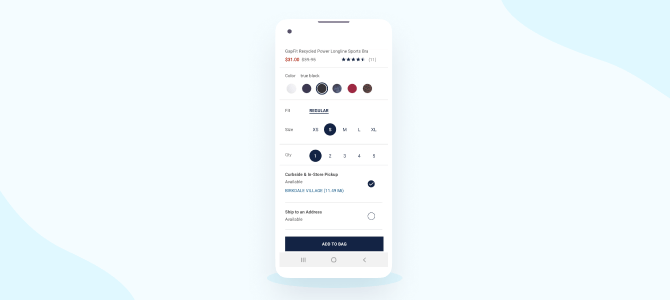
But even better, an app also tells Gap employees when it’s time to replenish stock of a product or size on the sales floor.
Takeaway
The pandemic made BOPIS (buy online, pick up in-store) a consumer expectation. While most e-commerce websites will support BOPIS, your mobile app should, too. That means having a Gap-like stock checker and a way to place a pick-up at store order. Some stores, like Best Buy, even allow you to text when you’re on the way.
L’Oréal’s try-before-you-buy AR
Changing hair color is a big deal. L’Oréal’s app lets you try out your ‘do’s new hue before committing to the process—without ever leaving the store.
The augmented reality-based app superimposes any L’Oréal color onto a real-time image on your mobile phone. Just pick the product and scan the box.
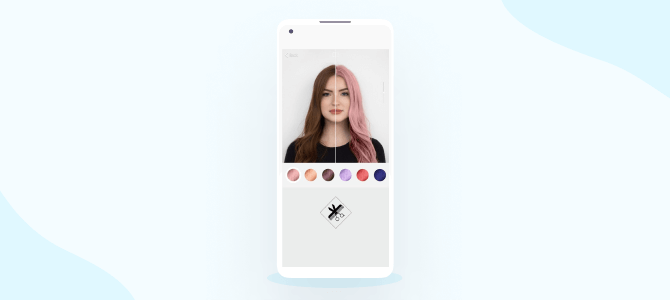
You can even try on makeup the same way. Once you’ve picked the perfect shade, either check out at the store or add it to a list for future delivery.
The lesson
Augmented reality is the ideal technology for improving real-life experiences—it’s right there in the name. Your app can use AR in lots of ways. Try gamifying a trip to your store with a virtual scavenger hunt (a-la Pokémon Go). Or allow shoppers to scan a box and engage with a virtual version of a product—reducing torn packages at the same time.
Nordstrom’s app-enabled fitting room
Fitting rooms are an important tool in the battle against high return rates. Shoppers aren’t always thrilled with the experience, though. So Nordstrom created a dressing room concierge service through its app, reducing the stress to dress.
Through the app, Shoppers reserve clothes to try on in the store. Associates gather the pieces and place them in a dedicated dressing room—texting shoppers once it’s ready.
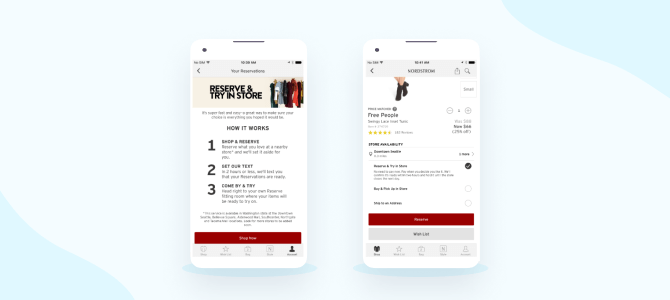
According to Nordstrom’s press release, an early trial of the try-on reservation service was well-received; 80% of customers that tried it returned to use it multiple times.
The lesson
Even if you don’t sell apparel, you can take a page from Nordstrom’s playbook. For example, allow app users to schedule time with a dedicated associate to learn about big-ticket items. Or sign up for in-store group classes or demonstrations. Then follow up with same-day discounts to increase conversions.
Pilot Flying J’s fuel for weary road warriors
The Pareto Principle suggests that 80% of your sales come from 20% of your customers. Whether that figure is accurate at your company, the point is that repeat customers are critical to growth. Pilot Flying J uses its app to surprise loyal visitors with perfectly timed bonus deals.
App users that have opted in to geolocation services and push notifications get personalized discounts on products based on previous behavior. So if a driver frequently stops by for their morning coffee, they may get a deal on a breakfast treat to go with it.

Such offers give loyal customers a little unexpected joy and can help increase their average purchase value.
The lesson
Discounts are a powerful motivator, but they’re not the only way you can delight frequent buyers while they’re in a store. Try reminding shoppers to pick up frequently bought consumables (because no one likes running out of lip balm). And let them know when a new flavor of their favorite beverage hits the shelf.
Ben’s Original’s infinite package
Transparency is non-negotiable for today’s consumers. Unfortunately, product packaging only has so much space to educate customers. Ben’s Original (formerly Uncle Ben’s) app gave discerning shoppers a view into its product origins like no package ever could.
For a limited time, French shoppers who downloaded the app could scan a pack of basmati rice and learn about the farmers who grew it.
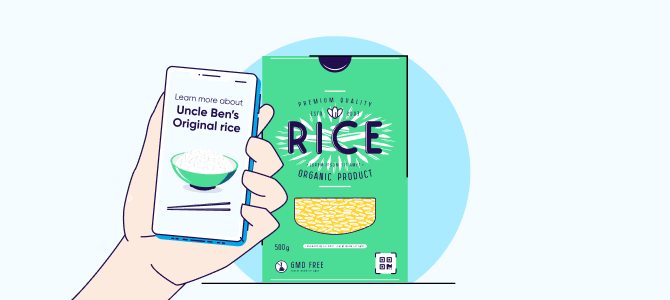
The multi-media presentation included video, images, and copy to highlight the brand’s commitment to sustainability.
The lesson
An app and a scannable package code offer limitless opportunities (think: recipes, reviews, how-to videos) to build customer confidence right when they’re deciding which product to buy.
Walmart’s scan & go
Waiting in line can feel like torture—and it leaves a bad impression on an otherwise good shopping experience. Walmart’s scan & go app lets shoppers jump the line and fly through the checkout process.
Here’s how it works. Customers open the Walmart+ app, scan product barcodes as they shop, then scan the QR code from their app at self-checkout. There’s even a running total in real-time so that shoppers can skip the sticker shock, too.

As a bonus, scan & go also means contactless checkout—making the whole process safer for everyone.
The lesson
There are other ways to apply the scan-and-go theme. Shoppers could scan items into a wish list while perusing your store, even turning the list into a wedding or holiday gift registry (hopefully, Santa has your app). Then those lists become another way to personalize offers, discounts, and content.
The Home Depot’s brick-and-mortar map
Search an online shop and you’ll find the perfect product with a few mouse clicks. Finding that same item down at a cavernous home improvement store may not be so easy. At The Home Depot, there’s a map for that.
Say you’re at a brick-and-mortar Home Depot looking for, well, bricks and mortar. Just open up the HD app and search like any e-commerce site. The in-store product locator highlights the exact location of your items.

The app also lets you know when an item is out of stock, so you don’t spend precious time searching for something that’s not there.
The lesson
An in-store product locator is a time-saving feature that mimics online shopping convenience. So is a “people also buy” list. Because no one likes getting all the way home only to realize they didn’t buy batteries.
Respect privacy, provide real value
Respecting your customer’s privacy isn’t just a good idea (creepiness is not a great growth strategy), it’s quickly becoming the law. As legislatures and operating systems prioritize user privacy, you’ll need to excite customers about the prospect of opting in to your app’s best features.
Not everyone can offer 1-cent hamburgers, so you’ll have to be creative. Sharing reviews of happy app users is a solid way to use social selling. Coupons and discounts can work, but you may lose users long-term if there’s no ongoing value. Loyalty programs with regular perks are a good play if you can connect them to app features.
But most of all, make sure the features you’ve offered in exchange for opting in provide real value to the people using them.
Key takeaways
Shoppers say they want the best of both worlds: app-like convenience with in-person experience. Here’s how you can give it to them:
- Send offers at the perfect time using geofencing and push notifications
- Make product education and trials better using QR codes on packages and reserable fitting rooms
- Help shoppers find products in your physical stores with stock checker and map
- Reduce purchase friction with scan-and-go capabilities
- Increase basket size with “people-also-purchase” messages while shoppers use your app in-store




